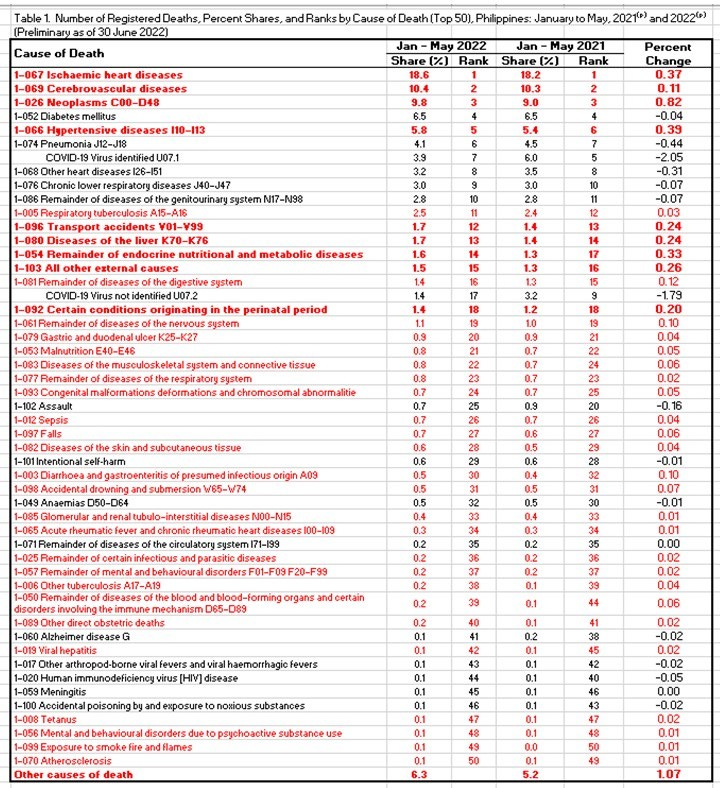PSA Has New Data Drop on 15 September Updating the January to May 2022 Vital Statistics as of 30 June 2022, as well as Cause of Death Data for the Same Period.
Incomplete data still limits the drawing of any conclusions on vital statistics and population outcomes for 2022. However, initial COD data indicates worsening metabolic health outcomes!
Updated Vital Statistics Data
A new data drop providing preliminary vital statistics data for Jan to May 2022, as of 30 June 2022 was released on 15th September 2022. The prior release of 2022 data was last 18 August 2022 (ref. my download; prior file no longer on the PSA site), when data for January to May 2022 as of 31 May 2022 was released. This release covers the same period, but now includes data compiled as of 30 June 2022.
Since the prior release of data last 18 August, there is an increase in registered births of 92,166, bringing total births from January to up to 343,032, still well below the 503,746 births for the same period in 2021. There was a 6% increase in registered births in January 2022, compared to January 2021. This data is clearly still incomplete, particularly for April and May. This is expected as, based on historical precedent, it takes 3 to 5 months for registered birth and death data to be received and compiled. Widespread population vaccination began in 3rd quarter of 2021; the impact of the vaccine on new pregnancies should be expected to be seen starting 10 months later in the 2nd and 3rd quarters of 2022. Data is still too incomplete to draw any conclusions with regards to this.
Since the prior release there is an increase in registered deaths of 50,592, bringing total registered deaths from January to May 2022 up to 208,099. This is also still well below the 318,888 deaths for the same period in 2021. January 2022 shows 16% excess deaths vs. January 2021. Data appears to still be substantially incomplete.
Cause of Death Data
Cause of death (COD) data was also released on 15th September 2022 covering the same period of January to May 2022. Due to the 2022 data clearly being substantially incomplete we cannot compare raw 2022 data with raw 2021 data. Instead, it is more useful to look at the % share of total deaths for the leading causes of death. While Covid-19 (virus identified and virus not identified categories) decreased as % contributors for COD, Ischaemic Heart Disease, Cerebrovascular Disease, and Hypertensive Diseases all increased! Diabetes remained stable.
Ischaemic heart disease was the No. 1 leading assigned cause of death in both years, attributing an 18.2% share in 2021 and increased by 0.4% to an 18.8% share in 2022.
Cerebrovascular disease increased from a 10.3 in 2021 to a 10.4% share in 2022.
Cancers were ranked 3rd and showed an increase from 9% in 2021 to 9.8% in 2022.
The 4th ranked COD was diabetes, which held steady at 6.5%.
Hypertensive diseases rose to from 6th place in 2021 to 5th place in 2022 increasing from a 5.4% to a 5.8% share.
Covid-19 Virus Identified dropped from a 5th place ranking in 2021 COD to a 7th place ranking in 2022. It contributed a 6% share in cause of death in 2021 and only a 3.9% share in 2022. Deaths from Covid-19 Virus not identified dropped from 9th place in 2021 at 3.2% to 17th place in 2022 at 1.4%.
A better understanding of population outcomes will not be possible until the data is more complete. Regardless, the changes in COD are very concerning because they indicate worsening population metabolic health. The apparent increase in cancers is concerning. Is this due to missed medical care, or is there any other possible cause?
Public health education, not on covid-19, but on lifestyle measures to address and reverse metabolic diseases is clearly warranted.
Increased poverty, the result of 2 1/2 years of lockdowns and restrictions, is also associated with worsening metabolic health; where cheap carbohydrates fill tummies but don’t meet nutritional needs for protein, fats, vitamins and minerals; malnutrition and obesity coexist. Education will need to be combined with increased access to nutritious foods.
Failure to address adequacy of nutrition with its stunted physical and intellectual growth consequences will add insult to the injury of 2 1/2 year of mostly lost education to Filipino children due to school closures.
This child whose story was recently shared may be a posterchild for the problem.









Have you noticed the infographic on the PSA website? Seems to use quite a bit of ‘whataboutery’ to blame it (the massive excess mortality) on more people getting old!